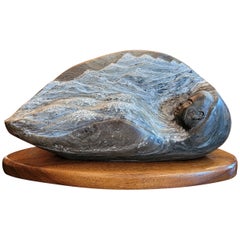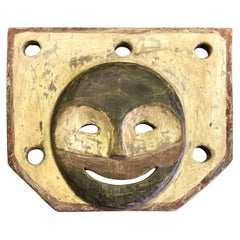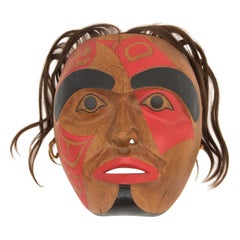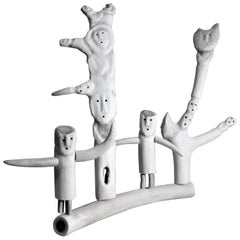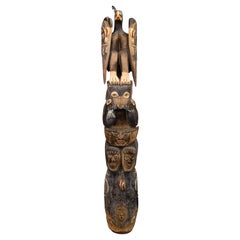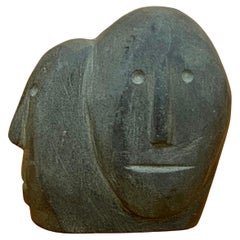Hand-Carved Native American Objects
to
17
57
2
68
1
9
1
1
9
8
51
1
7
21
9
1
1
1
1
1
1
1
2
46
20
16
6
5
67
50
14
1
1
69
69
69
9
2
Technique: Hand-Carved
Sleepy Mountains Sculpture by RD Tsosie
Located in Dallas, TX
Presenting a gorgeous piece of native American art, namely, “Sleepy Mountains” Sculpture by RD Tsosie, made from polished agate.
By the renowned Na...
Category
20th Century American Native American Hand-Carved Native American Objects
Materials
Agate
Yupik Yup'ik Native American Alaska Polychrome Wood Anthropomorphic Spirit Mask
Located in Studio City, CA
A beautiful, somewhat benevolent mask by the Yup'ik (Yupik) aboriginal, indigenous people of South-Western & South Central Alaska. The Yup'ik people, who are related to the Inuit peoples, have a long history of ceremonial mask making. Yup'ik masks were originally and specifically designed by Shamans and made to be worn by these spiritual leaders in Winter tribal dances and sacred ceremonies. Traditionally, the masks were destroyed or discarded after use in these ceremonies. Very few of these masks survived. After Christian contact in the late 19th century, masked dancing was suppressed and the tradition all but died out. As more outsiders settled in Alaska at the turn of the century, masks were made by the Yup'ik people to sell or trade for necessary goods. It is likely that this mask was created some years later for this purpose.
In the 20th century, Yup'ik mask had a profound influence on many renowned surrealist artists including, Max Ernst, Joan Miro, Leonora Carrington, Victor Brauner, and most notably Andre Breton who was an avid collector of Yup'ik masks.
This fantastic anthropomorphic mask is carved of lighter wood and hand painted/ decorated with pigment. The mask seems to represent some sort of smiling, benevolent spirit or character.
The mask is from a French collection. We were told that this mask, as well as others in the collection we have listed, was acquired originally in the 1950s-1960s in Alaska and the Yukon territory in Canada but as we have no way to verify or authenticate this. Please note we are listing the masks as decorative and not as actual tribal artifacts...
Category
20th Century American Hand-Carved Native American Objects
Materials
Wood, Paint
Signed Northwest Coast Killer Whale Mask, Attributed to Johnny Johns
Located in Denver, CO
This striking hand-carved wooden mask from the Pacific Northwest Coast powerfully embodies the rich artistic traditions and cultural symbolism of Indigenous coastal peoples. Featurin...
Category
Mid-20th Century American Native American Hand-Carved Native American Objects
Materials
Wood, Bentwood
Large Hand Carved Inuit Stylized Figurative Sculpture
Located in Hamilton, Ontario
This handcrafted sculpture was made in Northern Canada by an Inuit artisan in circa 1970. This sculpture is a series of two stylized human figures intermixed with two representations of presumably Spirits, which has several carved faces in them. The entire sculpture is composed of hand carved and handcrafted antler, likely Caribou. This sculpture may symbolize a blessing of good fortune for an upcoming hunt. The series of four figures are each pegged on the bottom and fit into holes drilled into the base. The base is numbered on the bottom which identifies that it was registered, and also has a paper label. Due to the composition of this sculpture it may only be shipped within Canada...
Category
Late 20th Century Canadian Native American Hand-Carved Native American Objects
Materials
Antler
Simon Charlie 9 Foot "Pole of Wealth" TOTEM
Located in Coeur d'Alene, ID
Simon Charlie "pole of wealth". Carved in Duncan, BC 1958 for Patrick Pryor who is in the timber business. Compared to the "pole of wealth" in Duncan, BC, you will see Simon's fingerprints. The adzed marks on the bear are identical to this totem. Also, the happy and sad faces are almost identical including their orientation left and right. This pole was carved by Simon in 1988. He used happy and sad faces in some of his work to notate good times and bad times. 9'2"H x 20" at base. Charlie was trained by famous Kwakwaka'wakw totem artist Henry Hunt, at the Provincial Museum of British Columbia, but though as Hunt he carved Totem poles, which was not traditionally used by the Coast Salish...
Category
Mid-20th Century American Native American Hand-Carved Native American Objects
Materials
Wood
Surrealist Inuit Basalt Sculpture of Two Faces
Located in Round Top, TX
A fine mid 20th C. Inuit sculpture from a remote Arctic village. A very lively expressive carving of two faces in basalt stone. Signed in Inuktitut syllabics; we have not determined ...
Category
Mid-20th Century American Native American Hand-Carved Native American Objects
Materials
Stone
Antique Folk Art Carved Gesso over Wood and Hand Painted Native Man Statue
Located in Hamilton, Ontario
Presumed to date from the late 19th century, this life-sized Folk Art carved and hand painted study depicts a Native man dressed in traditional attire and holding a staff. The artist is unknown and this sculpture is unsigned and done in a very realistic style. The carving, likely done in Cyprus wood...
Category
Early 19th Century American Folk Art Antique Hand-Carved Native American Objects
Materials
Softwood, Paint
$5,995 Sale Price
73% Off
Pair of 18th Century Native American Tobacco Store Hanging Trade Figures
Located in Nantucket, MA
Extremely rare and very special pair of 18th century native American tobacco store hanging trade figures, hand carved in the half round full length figur...
Category
18th Century American Rococo Antique Hand-Carved Native American Objects
Materials
Wood
19th Century Hand Carved Bark Canoe Bailer
Located in Coeur d'Alene, ID
19th century hand-carved bark canoe bailer from Minnesota. Fur trade era.
Period: 19th Century
Origin: Minnnesota
size: 9" x 6" x 5"
Family Owned & Oper...
Category
19th Century American Native American Antique Hand-Carved Native American Objects
Materials
Wood
Recently Viewed
View AllMore Ways To Browse
West Coast Totem Pole
Beaded Indian Moccasins
Indian Arrowheads
Model Totem Pole
Native American Blackware
Antique Indian Beadwork
Antique Indian Dolls
Antique Inuit
Native American Drums
Northwest Coast Totem Pole
Tlingit Art
Carved Wood Raven
Coast Salish
Crow Beaded
Sioux Beadwork
Antique Native American Drum
Antique Native American Rings
Beaded Leggings
